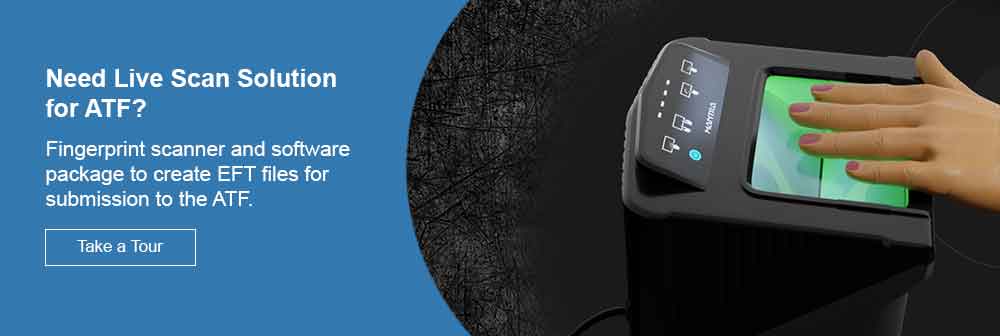
What is an EFT File? Understanding the FD-258 to EFT File Conversion.
FD-258 fingerprint cards, commonly known as FBI Applicant Cards, have been used for many years to gather fingerprints for employment, immigration, and other legal purposes. Although digital fingerprinting is improving, the conventional ink method remains in use.

Converting FD-258 to EFT File.
Law enforcement agencies like the FBI do not use ink cards directly. Instead, they convert them into digital files compatible with their fingerprint identification systems, like the FBI's NGI (previously known as IAFIS). For agencies that cannot electronically convert paper fingerprints, the Card Scanning Service (CSS) can assist.
Agencies can process fingerprints faster when they are submitted digitally. Agencies like the ATF are also transitioning to digital submissions, modifying their systems to accept biometric EFT files.
What Exactly is a Biometric EFT File?
An EFT file is a digital record that contains your fingerprints and personal information. It allows for electronic sharing and compatibility with the FBI's automated fingerprint systems. It adheres to the specifications established by the FBI's Criminal Justice Information Services (CJIS) for the Integrated Automated Fingerprint Identification System.
Differences Between EFTS and EBTS:
The Electronic Fingerprint Transmission Specification (EFTS) and the Electronic Biometric Transmission Specification (EBTS) specify how biometric data should be transmitted electronically. EBTS, created for the Department of Defense's Automated Biometric Identification System (ABIS), incorporates additional features to meet specific military requirements.
We are creating and submitting an EFT file.
You'll need FBI-approved fingerprinting equipment and software to create an EFT file. The process involves scanning your fingerprints and saving them and your personal information to a computer file. This file can then be electronically sent to agencies such as the ATF, which speeds up the approval process over sending physical cards.
From FD-258 Card to EFT File
If you start with an FD-258 card, the conversion involves scanning the card and turning it into a digital fingerprint record, which is then recorded as an EFT file using fingerprinting software. This strategy eliminates the requirement for actual cards, speeding up the processing of your application.
When compared to the old technique, submitting fingerprints electronically with an EFT file saves time and reduces the possibility of errors, resulting in speedier application processing.
Why the transition to digital fingerprinting matters
The transition from traditional FD-258 fingerprint cards to digital EFT files represents a significant advance in forensic and administrative technology. For one, digital fingerprinting offers greater accuracy and dramatically minimizes the likelihood of errors often connected with the physical manipulation of ink cards. Furthermore, digital fingerprints can be processed and cross-referenced against national and international databases much more rapidly, enabling quicker background checks and responses from law enforcement agencies.
How Digital Fingerprinting Works
When you use a digital fingerprinting service, your fingerprints are scanned directly into a computer system using a high-resolution scanner. This technology captures fingerprints and frequently includes features that instantly assess the print quality and allow for immediate retakes if necessary. The data is then formatted into an EFT file containing the required demographic information and high-quality fingerprint images.
Enhanced security with EFT files.
The use of EFT files also promotes security. In contrast to physical cards, which can be lost or intercepted, digital files are encrypted and delivered via secure networks, lowering the danger of data theft or tampering. Once acquired, these digital files can be linked into current automated systems, allowing for speedier processing.
The Broader Impact of EFT Adoption
Adopting EFT files means more than efficiency for law enforcement and regulatory agencies—it enhances the ability to identify individuals and solve crimes quickly. For the general public and applicants, it means faster processing times for applications that require background checks, such as job applications, licensing, and immigration procedures.
Challenges and Considerations
Despite these advantages, the transition to digital fingerprinting creates obstacles, especially for smaller agencies or those in developing regions with limited access to advanced technology. The initial setup cost for digital fingerprinting equipment and training personnel can be substantial. Furthermore, updates and maintenance are required regularly to ensure the systems' security and functionality.
Looking ahead.
As more agencies adopt digital systems and the technology becomes more accessible, we can expect further speed, accuracy, and interoperability enhancements among different systems and countries. The move towards digital fingerprinting is critical in modernizing security and background check processes, ensuring they meet the demands of a fast-paced, digital world.

By understanding the nuances of the FD-258 to EFT file conversion process and its implications, agencies and individuals can better prepare for and navigate the digital future of fingerprinting.
Comments